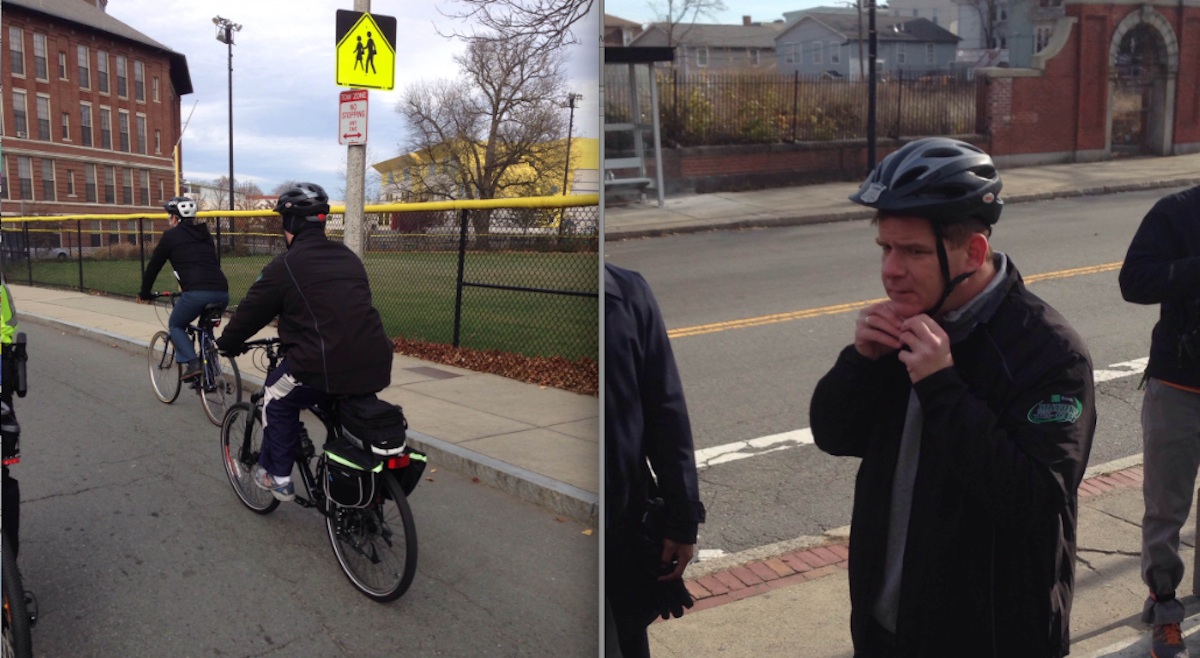Mayor Marty Walsh Goes For a Bike Ride
When he mounted the bike at the Dudley Town Common he was a bit wobbly, his knees jutting out to the sides as he tried to steady the handlebars and keep the front wheel straight. But within a block from the neighborhood park space, and with the guidance of seasoned riders, Mayor Marty Walsh steadily pedaled along the busy streets of Boston with relative ease for a full four miles.
It was the first time in years that the mayor took such a long trip on two wheels, but he wanted to prove to the bike community that he’s invested in making sure new infrastructure and changes to the street-scape address cyclists’ concerns, so that Boston can remain one of the top bike-friendly communities in the country.
“As I talk about future transportation plans for the city, and what we are going to look like, bikes have to be a big part of that infrastructure,” he said.
Walsh’s Saturday morning bike ride took the mayor, and more than a dozen cyclists from various advocacy groups, from Dudley Square to the Boston Police Department, through the Fens toward the Museum of Fine Arts, past Fenway Park, up into Brookline—briefly—before ending on Commonwealth Avenue, at Landry’s Bicycles, across from Boston University.
“The ride was good. It showed me that I need to exercise more,” Walsh said after the trek concluded around noontime. “From a biking perspective, it was certainly eye-opening. I didn’t get the full effect of riding by myself, but coming down Comm. Ave., where the cars are there, it really opens your eyes.”
The ride was Walsh’s way of following through on a promise that he made to Allston resident and avid cyclist Galen Mook, who asked the mayor during his campaign to take a ride with him, and Boston Cyclists Union executive director Pete Stidman.
At first, a conflict in Walsh’s schedule kept the mayor from making good on his guarantee. When Mook didn’t hear back from the mayor, once he took office, Stidman stepped in and texted Walsh directly, ultimately making Saturday’s trip around the city come to fruition after months of “bugging” him. Mook and Stidman were joined by Boston Bikes; representatives from the non-profit group Bikes Not Bombs; Nicole Freedman, the city’s resident “bike czar,” and John Barros, Walsh’s chief of economic development.
“I thought he did fantastic,” said Mook. “I was a little worried—he didn’t seem too confident in the beginning, but hopefully when he rides some more he gets more comfortable.”
Mook said talking about infrastructure, and what needs to change to make Boston better for bikes is important, but the real point of the ride was to get Walsh to “feel how fun it is” to ride in the city.
“I looked back and he was smiling,” said Mook. “That’s the best part of it. Really I wanted this to be very friendly and very open, and I wanted this to be casual. The bike community can come across as abrasive and demanding when we show up at public meetings, and it can come across as a little bit too negative. I wanted this to be friendly, fun, and open, which I think it was.”
While Walsh enjoyed himself, he didn’t discount the fact that the city is a long way from offering the perfect terrain for daily cyclists. Certain things stuck out to the mayor as the large group of bike advocates and a police detail guided him along on the Saturday morning tour, specifically that there’s “more work to do on some of our streets.”
“We have done the first steps, but this was a good first step to show how committed I am [to the bike community],” the mayor said. “One ride isn’t going to be enough, but now it’s what my actions are after the ride.”
Walsh specifically pointed out the “contraflow lane” riders passed through in Brookline, stating that it “jumped out” more to both cyclists and drivers.
Contraflow lanes are brightly marked bike lanes that allow riders to travel down one-way streets in the opposite direction of cars, something that would make it easier to navigate Boston, a city filled with roads that have limited access. “It just stuck out more,” he said, adding it was something he’d talk about with his administration. “It was painted and yellow, and stood out a little more than just a white lane.”
Walsh said he is also going to take a harder look at plans for Commonwealth Avenue, a busy stretch of roadway that’s been home to bike fatalities, doorings, and multiple crashes over the years. A portion of the road, near the Boston University Bridge, is set to undergo big changes to the surrounding sidewalks, streets, and berths in front of the MBTA Green Line train stops. Cyclists have been rallying for vast improvements to the road as part of the reconstruction plans to ensure greater safety for commuters.
“To do something this early in his administration is a good sign,” Mook said of Walsh’s willingness to attend the meet-up. “Now he’s got three-and-a-half years in this term, and this is a very good start to get him plugged in…he was true to his word.”
Members of Bikes Not Bombs were also pleased with Walsh’s efforts to include young people of color on the ride, and talk with them while biking through their neighborhoods.
“I feel like it was nice. For the first time getting to meet him close up, and him getting involved in the community, it’s great to see a mayor like that,” said Jesse Bland, a volunteer at Bikes Not Bombs. “I could say he’s like another Mayor Menino—going into the community and helping out. He did pretty well. He can ride a bike. It was pretty amazing how well he could ride. It was an inspiration to see him ride with us.”


